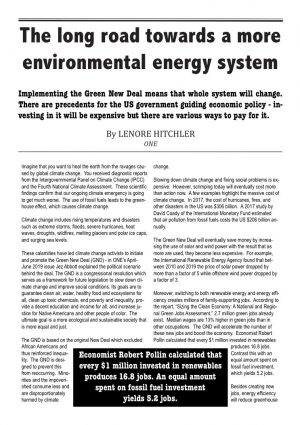 Imagine that you want to heal the earth from the ravages caused by global climate change. You received diagnostic reports from the Intergovernmental Panel on Climate Change (IPCC) and the Fourth National Climate Assessment. These scientific findings confirm that our ongoing climate emergency is going to get much worse. The use of fossil fuels leads to the greenhouse effect, which causes climate change.
Imagine that you want to heal the earth from the ravages caused by global climate change. You received diagnostic reports from the Intergovernmental Panel on Climate Change (IPCC) and the Fourth National Climate Assessment. These scientific findings confirm that our ongoing climate emergency is going to get much worse. The use of fossil fuels leads to the greenhouse effect, which causes climate change.
Climate change includes rising temperatures and disasters such as extreme storms, floods, severe hurricanes, heat waves, droughts, wildfires, melting glaciers and polar ice caps, and surging sea levels.
These calamities have led climate change activists to initiate and promote the Green New Deal (GND) – in ONE’s April-June 2019 issue Jez Abbott explained the political scenario behind the deal. The GND is a congressional resolution which serves as a framework for future legislation to slow down climate change and improve social conditions. Its goals are to guarantee clean air, water, healthy food and ecosystems for all, clean up toxic chemicals, end poverty and inequality, provide a decent education and income for all, and increase justice for Native Americans and other people of color. The ultimate goal is a more ecological and sustainable society that is more equal and just.
The GND is based on the original New Deal which excluded African Americans and thus reinforced inequality. The GND is designed to prevent this from reoccurring. Minorities and the impoverished consume less and are disproportionately harmed by climate change.
Slowing down climate change and fixing social problems is expensive. However, scrimping today will eventually cost more than action now. A few examples highlight the massive cost of climate change. In 2017, the cost of hurricanes, fires, and other disasters in the US was $306 billion. A 2017 study by David Coady of the International Monetary Fund estimated that air pollution from fossil fuels costs the US $206 billion annually.
The Green New Deal will eventually save money by increasing the use of solar and wind power with the result that as more are used, they become less expensive. For example, the International Renewable Energy Agency found that between 2010 and 2019 the price of solar power dropped by more than a factor of 5 while offshore wind power dropped by a factor of 3.
Moreover, switching to both renewable energy and energy efficiency creates millions of family-supporting jobs. According to the report, “Sizing the Clean Economy: A National and Regional Green Jobs Assessment,” 2.7 million green jobs already exist. Median wages are 13% higher in green jobs than in other occupations. The GND will accelerate the number of these new jobs and boost the economy. Economist Robert Pollin calculated that every $1 million invested in renewables produces 16.8 jobs. Contrast this with an equal amount spent on fossil fuel investment, which yields 5.2 jobs.
Besides creating new jobs, energy efficiency will reduce greenhouse gases. For instance, weatherization is predicted to decrease annual emissions by around 2.65 metric tons of carbon dioxide (CO2) per home.
Initially investing in the Green New Deal will be expensive. However, there are various ways to pay for it. The GND resolution proposed creating public banks similar to the use of the New Deal’s Reconstruction Finance Corporation, which served the function of a bank and lent money to states and companies. Federal Reserve and government bonds could provide funding as well. Also, how energy is distributed affects pricing. Public and cooperatively owned energy is cheaper than for-profit power.
Federal and state governments should abolish subsidies, including tax breaks, to the fossil fuel industry, freeing up billions for the GND. The US and individual states provided $20.5 billion a year in 2015 and 2016 to the oil, gas and coal industries. In the past, Alaska provided $200 million per year for oil and gas drilling subsidies.
More money would also be available for the GND if financial institutions eliminated funding for the fossil fuel industry as many of them currently do. According to the report “Banking on Climate Change,” between 2016 and 2018, J.P. Morgan Chase provided funding of over $195 billion, Wells Fargo provided over $151 billion, Bank of America provided over $106 billion, and Goldman Sachs provided over $59 billion.
Extensive support already exists for the principles of the Green New Deal. The Yale Program on Climate Change Communications surveyed attitudes based on the laws of the GND. They found 92% support among Democrats, 64% among Republicans, and 57% among conservative Republicans. The GND is also popular with environmental and social justice groups – 626 organizations signed a letter to Congress urging lawmakers to implement some GND policies.
In general, there is widespread support for creating a more environmental energy system. Americans endorse regulation of fossil fuels. For example, 69% want limits imposed on CO2 emissions, and 64% of all registered voters think that Congress should be doing more to address global warming. Expanding alternative energy production is also supported by a majority of Americans. 76% support utilities increasing the use of solar power with 71% supporting more wind power. 82% support tax breaks for purchasing energy-efficient vehicles or solar panels.
One faction in the US asserts that the government should not interfere in the “free market.”
However, from the very beginning, there are precedents for the US government guiding economic policy. Even the Preamble of the Constitution refers to promoting the general welfare which the GND certainly does. According to Robinson Meyer, staff writer at the Atlantic, Treasury Secretary Alexander Hamilton supported a stable federal government which would guide the economy. Meyer stated that Hamilton “is the father of American industrial policy, which includes the set of laws and regulations that say the federal government can guide economic growth.”
According to Stephen Cohen, professor of city and regional planning at UC Berkeley, Hamilton fought for creating an infrastructure for the country and a robust financial system. Cohen added that later economic policy included providing land to build the transcontinental railroad. President Eisenhower’s administration built the interstate-highway system leading to suburbanization and the predominance of private automobiles.
Another precedent is President Roosevelt’s New Deal, which was extremely popular, and had many accomplishments, including employing millions, mandating a minimum wage, establishing unemployment insurance and supporting the right to form unions. The Rural Electrification Administration brought electricity to 95% of rural America. A massive public works program built thousands of bridges and highways and additionally engaged in environmental restoration. The Civilian Conservation Corps planted more than 3.5 billion trees which represent over half of total US reforestation. More than 800 new state parks were established.
Besides creating the New Deal, President Roosevelt led the US in World War II. Warfare is a terrible burden for both the environment and humanity and is certainly not recommended as a way to change society. However, it demonstrates that emergencies can be handled rapidly. Government policy during World War II changed the entire focus of manufacturing. Thomas Morgan published “The Industrial Mobilization of World War II: America Goes to War” in Army History. He stated that the US produced 310,000 planes, 124,000 ships of all types, 100,000 tanks and armoured vehicles, 2.4 million other vehicles, 434,000 tons of steel, and 41 billion rounds of ammunition. By 1944, 18.7 million more people were employed than in 1939.
To conserve resources for the war effort, the government rationed many items including metals, rubber, fuel oil, firewood, coal, paper, sugar, cooking oil, butter, cheese, meat, and processed food. The entire country’s acceptance of such hardships shows that under the right circumstances, citizens will accept massive changes in their lifestyles.
Implementing the Green New Deal means that whole system will change. For example, the GND resolution includes changes to the transportation system, which consumes massive amounts of fossil fuels. As of 2015, shipping emissions accounted for 3% of global CO2. Also, to save energy, cross-country trucking should be replaced with freight railways.
Public transportation should be expanded as it conserves an estimated 4.16 billion gallons of gas per year. Commuting to work by subway emits 73% less CO2 than by car. Four times as much federal money goes into roads than public transport. Analysis by Smart Growth America, the Center for Neighborhood Technology and US PIRG found that every billion dollars spent on public transportation produced 16,419 jobs. Only 8,781 jobs are created for the same amount of money spent on highway infrastructure.
Reliance on private vehicles should be decreased by providing convenient and pleasant alternatives. For every mile driven, one pound of CO2 is produced. Each gallon of gasoline emits 28 pounds of CO2 in the production process and actual use.
More sustainable cars such as hybrids are already on the market. Innovations are constantly added. One example is Segun Oyeyiola of Nigeria’s reconditioned car. He placed a solar panel on top and added a wind turbine under the hood. He explained that this allows air to flow while moving, turning the turbine’s rotors and charging the battery.
The Green New Deal will also improve the agricultural system. Changes must be made in how food is produced so that the use of fossil fuels is reduced. As opposed to farmers being forced to leave agriculture for financial reasons, labour-intensive carbon farming would create many new jobs. Current harmful agricultural practices have caused the world’s cultivated soils to lose between 50 and 70% of their original carbon stock, which has oxidized to become CO2. According to Rattan Lal, director of Ohio State University’s Carbon Management and Sequestration Center, one-third of the carbon in the atmosphere was originally found in the soil.
By relying on natural processes, carbon farming takes excess carbon out of the atmosphere and stores it in the soil. More fertile the soil, more carbon it holds. John Norman, University of Wisconsin soil scientist, found the carbon farm that he studied stored around 80 tons of carbon per acre, whereas the typical farm stores 10 to 20 tons of carbon per acre. Incentives, such as tax breaks, should be provided for switching to carbon farming.
According to author Carolyn Fortuna, PhD, “Some scientists project that 75 to 100 parts per million of CO2 could be drawn out of the atmosphere over the next century if existing farms, pastures, and forestry systems were managed to maximize carbon sequestration.”
In addition to carbon farming, there are many other ways for the food system to become more sustainable. Purchasing local produce and planting family gardens reduce fossil fuel-based transportation. During WWII, there were 20 million victory gardens which supplied 40% of the country’s fruits and vegetables. Planting vertical gardens is another way to increase yields.
Using trees in agriculture would be more ecological and increase sustainability. Trees with legume pods could feed livestock. Since they are perennials, they would not have to be sown yearly and would replace tilling, which adds CO2 to the atmosphere. The amount of land and energy devoted to grains for livestock would be reduced. One-third of all food that is grown is wasted and correcting this would lead to saving both land and energy.
Energy efficient buildings are another feature of the GND. A new policy should include mandates to use passive solar designs, which use much less energy, for new buildings. Power should also be produced onsite. Solar panels or green roofs should be used on both new buildings and retrofitted on old buildings — solar water heaters lower water heating bills from 50% to 80%.
Clean energy production includes geothermal heating, ventilating and air conditioning systems which do not burn fossil fuels to heat and cool but transfer heat to and from the earth. Concentrated solar power, using mirrors to concentrate the sun’s energy, can replace fossil fuel power plants.
Many wasteful practices should be eliminated. The government has abolished specific production before in an emergency. In 1942, President Roosevelt outlawed the production of passenger cars. Planned obsolescence and manufacturing items that can’t be repaired should cease.
Producing and transporting these wasteful products to landfills and then manufacturing replacements use too many resources and energy. Products such as plastic straws, bags, and bottles, which use too much petroleum while being made and pollute the environment, should be banned. Recycling saves resources and energy. By 2020, recycling alone could generate 2.5 million jobs.
The government should forbid fossil fuel campaign funding so that new legislation benefitting the fossil fuel industry will be not be enacted.
In the 2015-2016 campaign cycle, oil, gas, and coal companies spent $354 million in campaign contributions and lobbying. According to Oil Change International, the 88 senators who didn’t support the GND received almost $59 million from the fossil fuel industry.
There are even more changes that would help slow down climate change. Ending reliance on oil from the Mideast would result in less spending on preparation and implementation of wars for oil. Ending deforestation is also mandatory as it is responsible for about 20% of global CO2.
The prognosis for stopping climate change before it stops us is not good. However, the Green New Deal is an attempt to initiate various remedies. It prescribes new ways to slow down climate change and create a healthier environment. Intertwined with environmental improvements are poverty reduction, the creation of millions of family-supporting jobs, and increased justice for minorities.
Lenore Hitchler





